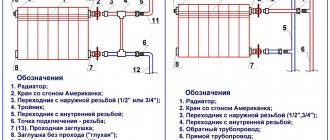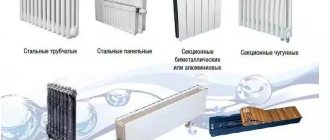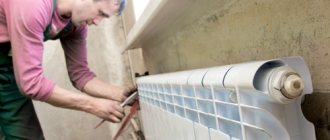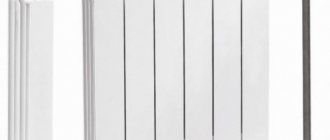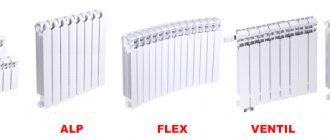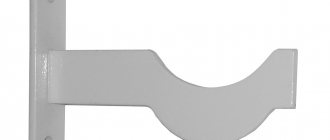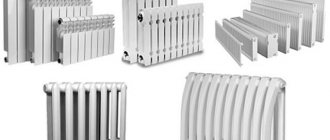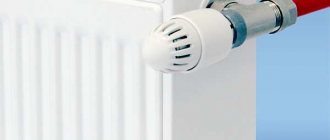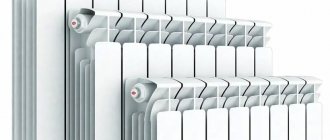Not so long ago, cast iron batteries were installed in many apartments, but they had a lot of disadvantages. Now technology is developing every day and innovative materials are appearing: for example, bimetal. This made it possible to produce radiators using two types of metals: one for the core, the other for the fins. In the second case, aluminum is always used, but the core is made of copper, cast iron or steel. The most common is the latter type. Bimetallic heating radiators are universal, that is, they are installed both in large country cottages and in apartments.
Bimetallic or semi-bimetallic radiators
Bimetallic heating devices are steel pipes connected by cold welding, which are coated with a layer of aluminum. Thanks to this, hot water does not interact with the outer shell of the radiator, which avoids corrosion. Moreover, aluminum is applied in the form of shaped plates, and this significantly increases the heat transfer area.
There are also copper cores for bimetallic radiators. They are suitable if the coolant is water with antifreeze. This composition can quickly destroy steel, but copper is resistant to it.
Semi-bimetallic radiators have a core made of two metals. All vertical channels are steel, and horizontal ones are aluminum. The disadvantage of such devices is that they are not suitable for water with a high alkali content. They definitely require a coolant purified from impurities.
Now there are many different brands on the market offering high-quality antifreeze. One of them is Gibax brand antifreeze. When choosing, you must remember that ethylene glycol and propylene glycol bases are not used in systems with galvanized pipes. For them, coolants made on the basis of glycerin are used.
Now about which heating radiators are better. For central heating systems, bimetallic devices are more suitable because they are resistant to pressure drops and low-quality contaminated coolant.
For an apartment it is better to choose bimetallic heating devices Source homeli.ru
Semi-bimetallic radiators are more efficient, but they require ideal conditions to function properly. They are more suitable for private homes, and are an order of magnitude more expensive than bimetallic devices.
Dimensions of bimetallic radiators: width, depth and height of sections
The performance characteristics and dimensions of bimetallic radiators are the first thing you should pay attention to when choosing a suitable model . You need to start with the dimensions. It is recommended to install heating devices in niches under windows; in this case, effective protection is provided from cold air “penetrating” through cracks in the frames from the street. The device must be freely located in the niche and provide sufficient heat.
Characteristics of modern bimetallic radiators in terms of geometric parameters:
- The distance between vertical channels (center distance) in standard models is 200, 350 or 500 mm . It must be remembered that the center distance is the size between the inlet and outlet pipes, and not the height of the device. To determine the full height dimensions, you should “add” 40 mm to each side. With an interaxial distance of 200, the final height of the radiator will be 280 mm, with a distance between the vertical channels of 350 mm, the height of the device will be 430 mm, etc. All bimetallic devices have a standardized height range, but in practice you can find devices with center distances from 200 to 800 mm .
- The standard width of one section is 80 mm . The total width of the device is determined by multiplying the number of sections by the width of each.
- The depth of the sections ranges from 80 to 100 mm.
Bimetallic or aluminum radiators
A little about which radiators are better, aluminum or bimetallic. In relation to the coolant, the advantage is clearly on the side of the latter. Aluminum does not withstand prolonged contact with water with large amounts of impurities.
Also, bimetallic radiators are more resistant to high pressure than aluminum ones. After all, the core is made of alloy steel, which has increased fracture and tensile strength.
However, in some aspects, bimetallic heaters are inferior to aluminum ones. They are bulkier and heavier, cost significantly more, and the steel core reduces energy efficiency and reduces heat exchange with the room.
Externally, aluminum and bimetallic radiators are very similar Source zamenabatareymoskva.ru
Bimetallic heaters definitely require increased heating costs. But they are more durable and more suitable for urban heating networks. At the same time, aluminum radiators are ideal for private homes, where owners can control the pressure and change the water in the system.
See also: Catalog of companies that specialize in equipment for engineering systems, including heating
Comparison with radiators made of other materials
To understand which product to give preference, consider the features of bimetallic and aluminum options.
We will compare according to the main parameters:
- Which material gives more heat ? In terms of heat transfer, aluminum wins. The power of one section is enough to generate 200 W of thermal energy. The fins protruding from the sections only increase heat transfer. As for bimetallic options, the level of heat transfer depends on the manufacturer. Due to the steel core, the overall indicator is reduced.
- Withstand high pressure . In this regard, aluminum is considered a weak material: it can withstand from 6 to 16 atmospheres, which may not be enough during pressure surges. In addition, an aluminum battery simply cannot withstand water hammer: it will burst, so in multi-story buildings this is not the most acceptable option. Bimetallic models, operating in the range from 20 to 40 atmospheres, perfectly withstand high pressure. This is due to the presence of a durable steel core. Even if the tap at the pumping station is closed and quickly opened, this will not affect the quality of the batteries. If the pressure in the system is unstable, it is best to install a bimetallic radiator.
- Relation to coolant . Aluminum is a material that reacts strongly to the content of foreign elements in water. First of all, this is corrosion: if the pH of the coolant exceeds 8 units, rust quickly begins to spread. The chemical reaction also causes aluminum to release hydrogen. Because of this, the batteries need to be vented from time to time. Steel pipes installed in bimetallic models receive less: they are not so demanding on the quality of the flowing liquid. Steel is chemically less active compared to aluminum alloys. Of course, corrosion may also appear, but not soon. Currently, manufacturers coat their products with special protective compounds.
- Maximum coolant temperature . Aluminum batteries can withstand no more than +110 °C, while bimetallic batteries can withstand +130 °C.
- Durability . Bimetal will last from 15 to 20 years, and aluminum only 10.
- Installation . Installation is simple in both cases, since the materials are lightweight compared to cast iron products. During the work, the use of powerful brackets is not required: even drywall will withstand the load. And yet, bimetallic batteries are easier to install, since steel pipes are stronger than aluminum and are more difficult to damage.
- Price . Bimetal products are 1/5 more expensive than aluminum products. Consumption also increases during operation, because bimetallic devices require more energy to pump liquid.
This was a comparison between aluminum and bimetal. But there are also cast iron products that have their own characteristics. First of all, such radiators are not afraid of aggressive environments, so any coolant can be used. Cast iron concentrates a lot of heat and does not leak.
However, this is a heavy material, so you can forget about installing batteries yourself. Cast iron has less heat transfer compared to aluminum, so the number of sections increases. And they do not provide a mechanism to regulate the temperature.
Types of bimetallic radiators
There are two main types - sectional and monolithic. Below we will tell you more about them and help you figure out which one is best for you.
Sectional radiators
They are assembled from several sections. Often made in the form of a “layer cake” made from heating plates. This discovery allows one to significantly increase the area of heat exchange with the environment. But there is a big drawback: any coolant destroys the joints of its component parts. As a result, a relatively short service life.
Sectional heaters consist of several parts Source forum.usolie.info
Monolithic radiators
They also have a large heat exchange area, so they are in no way inferior to sectional heaters. One section produces approximately 100-200 W. Monolithic radiators are manufactured using a fundamentally new technology: the entire body is cast and then pressure-treated. A layer of aluminum is applied under pressure on top of the steel frame.
Monolithic heaters are one whole Source www.teplodvor.by
The advantage of monolithic radiators is obvious. The service life is twice as long and is not 25 years, like sectional ones, but 50. But at the same time, they cost about a fifth more. Their disadvantage is that they do not allow adding additional sections and thereby adjusting the power.
If you think about the question of which heating battery is better for apartments in high-rise buildings, then the answer is clear - monolithic. The point is a large pressure drop due to altitude.
Recommendations for selection
At first glance, everything seems simple. But no, bimetallic products differ depending on the manufacturer and are not suitable for working with every coolant. Let's take a look at the main recommendations.
Which is better: sectional radiator or solid one?
Initially, bimetallic products were distributed in sections. But such radiators suffer over time from the quality of the coolant (joints are damaged, service life is reduced). And due to the high pressure in the system, the joints become an emergency place: this is where leaks most often occur. For this reason, a new technology was developed: the collector is made in one piece, and an aluminum “jacket” is installed on top.
Specifications:
- life time . Those consisting of sections last 20-25 years, and solid ones - up to 50;
- operating pressure . Sectional - 20-35 bar, solid - up to 100;
- thermal power for each section . For both options it is 100-200 W.
However, monolithic devices are more expensive than their earlier counterparts. One more nuance: models with a solid core cannot be modified, that is, additional sections cannot be built up. In turn, manufacturers produce many models that differ in size.
What to choose: copper or steel core
Many manufacturers produce hybrid models with a steel tube frame. This is due to the affordability of the material and good strength characteristics. By combining steel with aluminum, the result is a device that is resistant to pressure fluctuations, heat transfer is improved and inertia is reduced.
Copper core batteries have the following advantages:
- no corrosion;
- resistance to water hammer . For this reason, such models are relevant for domestic systems with centralized heating;
- efficiency . Copper has better heat transfer than steel.
A radiator made of copper and aluminum can last about 50 years. The copper modification has only one drawback - the high price.
How not to buy a fake
You need to be careful when choosing products on the market, as fakes are now widespread. The main difficulty here is that it is quite problematic to identify the real model by eye.
The following signs indicate a fake:
- less thick walls;
- deformed with little effort;
- poor painting (chips form);
- light weight;
- reduced dimensions;
- they heat the room poorly (the heat transfer parameter is 20-30% worse);
- leak frequently;
- the company logo is not displayed accurately;
- passport data differs from actual parameters.
Connecting a fake is highly not recommended, as this can lead to problems during operation of the heating system.
Rating of bimetallic heaters
Below we will help you figure out which batteries are best to choose for your home or apartment. Let's consider the operating conditions, workmanship and some nuances.
Global Style Plus 500
Suitable for central heating systems. Well adapted to high pressure and strong acidity of the coolant. The sections are connected by pipes with a silicone gasket that protects against leaks. The steel contour is crimped under high pressure, which allows it to withstand strong water pressure. Another advantage of this model is the high quality of painting.
Bimetallic heater Global Style Plus 500 Source m.onlinetrade.ru
But the downside will be the rather high cost. On average on the market it is 9,500 rubles. However, it is believed that the model is worth the money.
See also: Catalog of companies that specialize in the development of circuit diagrams and installation of engineering communications of any complexity
Rifar Monolit 500
A monolithic heater made in Russia, quickly gaining popularity. Made in the form of a single steel block, which eliminates the possibility of leaks. The radiator does not require a constant coolant temperature. Withstands pressure on the internal circuit up to 100 atmospheres. Rifar Monolit 500 provides high heat output with minimal energy loss.
Rifar Monolit 500 - a good heater from a domestic manufacturer Source klimatstandart.com
But there is one caveat: the dimensions of the Rifar Monolit 500 heating radiator are fixed, like any monolithic device. Therefore, if it turns out that there is not enough of it or, on the contrary, there is too much, simply adding or subtracting sections will not work.
Sectional or monolithic bimetal?
More common on the market is the sectional version of bimetallic heating radiators. This is justified by the fact that it provides greater scope for installation in various conditions. It allows you to easily add or subtract the required number of sections when calculating the heating area and has an affordable price.
The monolithic design has improved performance characteristics: it can withstand significantly higher coolant pressure, easily withstand even the most powerful water hammer and have a service life of 100 years. Leaks between blocks that are possible with sectional radiators are also eliminated. The described qualities are achieved due to a solid steel core, which has no weak points in the form of docking nipples.
The main disadvantage of monolithic bimetal is its high cost.
Video description
We recommend watching this short video review of the bimetallic radiator Rifar Monolit 500:
Sira RS Bimetal
One of the quietest heating radiators. Can even be installed in bedrooms. One block can include up to 12 sections, the number of which can be adjusted depending on the area of the room. The inner shell is made of special steel, which is not subject to corrosion and can be used in combination with low-quality coolant. Sira RS Bimetal provides a high level of heat transfer and is designed for a maximum pressure of 40 atmospheres, and the radiator is adapted to the water hammer typical of a central heating system.
Heating radiator Sira RS Bimetal can often be found in apartments Source on-lineclimat.ru
But this model has one drawback: the quality of painting leaves much to be desired. Despite this and the rather high cost, many experts, when asked which bimetallic radiators are better, will answer Sira RS Bimetal.
Royal Thermo Revolution Bimetall 500
Fourth place in our ranking of bimetallic radiators is occupied by Royal Thermo Revolution Bimetall 500. A very popular model from a domestic manufacturer. The device is adapted to fairly harsh operating conditions and provides good performance. The structure is wall-mounted, sectional, with an adjustable number of segments, the maximum number of which is 14 pieces. The Royal Thermo Revolution Bimetall 500 has a side connection. The heater is designed for operating pressure up to 30 atmospheres.
Bimetallic heating radiator Royal Thermo Revolution Bimetall 500 Source smauro.ru
The main factor that makes the model one of the most widespread in Russia is the price. You can buy a heater for an average of 4,100 rubles. However, it is worth remembering that with sharp increases in coolant temperature, the efficiency of the device decreases significantly.
How to calculate the number of sections
Based on plumbing standards, 100 W of power is required per 1 square meter of room. The calculation is as follows: the housing area is calculated - the length is multiplied by the width. The resulting figure is multiplied by 100 W and divided by the heat transfer of one section.
For example, let’s take a room 3 by 4 meters. It can be calculated using the above formula: K = 3 × 4 × 100 / 200 = 6. Here, the number 200 is the heat transfer rate of one section.
The calculation of sections of bimetallic heating radiators by area is more accurate. The calculations are similar, only the main data is the heating power for 1 m³. The normalized value is 41 W.
So, the room is 3 by 4 meters, the ceiling height is 2.7 meters. Volume (V) = 3 × 4 × 2.7 = 32.4 m³. Radiator power (P) = 32.4 × 41 = 1328.4 W. Number of sections (K) = 1328.4 / 20 = 6.64. The volumetric method is more accurate, as it takes into account the height of the ceilings, which will allow for optimal heating.
How to choose a bimetallic heater
When purchasing a device, it is important to consider a number of nuances. When going to the store, you need to know exactly what power the radiator should produce, what dimensions it should have, and to what conditions it should be adapted. Therefore, we will help you figure out which bimetallic radiator is best for your home.
Calculation of the number of sections
This calculation is made based on the area of the room and the energy efficiency of the section of a particular device. It is believed that for every 10 m2 of room there should ideally be 1 kW of power. To calculate, you need to divide the area of the entire room by 10, and then divide the result by the power of one section. Then the entire value must be increased by 10% and rounded to the nearest whole number. This is how heat loss associated with external factors is taken into account. The result will be the optimal number of radiator segments for a specific room.
A sectional bimetallic radiator can be adapted to a specific room Source cok.ru
If, due to some characteristics of the area or the house, the sectional heater does not provide the required temperature level, additional segments can be added to it. This cannot be done with a monolithic radiator.
Things to consider
There are several points that are worth paying attention to in order to understand which heating radiator is better in a particular case:
- It is better when the size of the heater is maximum , because in this case the energy efficiency of the device is the highest. But it is important that the distance to the floor is at least 12 cm, and to the window sill - at least 10 cm.
Ideally located bimetallic heating radiator Source tengrinews.kz
- Capacity is one of the most important parameters. The larger it is, the better the radiator heats. Therefore, devices with small volume sections require the highest quality coolant without impurities.
- Monolithic radiators are more suitable for apartments , because they can withstand sudden pressure surges, while at the same time, cheaper sectional models can be used for autonomous heating systems.
Types of bimetallic batteries
In addition to bimetallic ones, the production of semi-bimetallic radiators has now been established. It is important to understand what their differences are.
Fully bimetallic
In such models, aluminum is used only for the manufacture of the outer casing of the device. The production procedure is as follows: steel cores are placed in special molds and filled under pressure with aluminum, a material with good thermal conductivity. In turn, it does not withstand aggressive environments and high coolant temperatures. But, in solid, completely bimetallic versions, aluminum simply does not come into contact with the liquid - it is used purely as a heat exchanger. This design is optimal for central and autonomous heating systems.
Some models are not equipped with a copper core, but made of stainless steel: such batteries are suitable for autonomous systems with special antifreeze as a coolant.
Semi-bimetallic
Different metals are used to make internal channels for such batteries. For example, stainless steel is used to produce vertical pipes, and aluminum is used for horizontal pipes. There are also reverse options.
This variety is not installed in central heating systems, which is explained by the quality of the coolant, which may contain a high concentration of alkali. When in contact with aluminum, corrosion processes easily form. In addition, each metal has its own rate of thermal expansion. And if the system experiences extremely high temperatures, internal components can shift, causing a leak.
Often such radiators are confused with completely bimetallic ones, since visually they are no different. If the buyer does not understand the intricacies, he, as a rule, buys the cheaper version. But, looking at the description, you can see that this is not a particularly reliable investment.
Briefly about the main thing
Bimetallic radiators are superior to semi-bimetallic models in durability and unpretentiousness, and they are also more affordable.
Bimetallic radiators are more durable than aluminum ones, but are more expensive and take up more space.
According to the structure, there are two types of bimetal radiators: sectional and monolithic.
The most popular models of bimetallic radiators are Global Style Plus 500, Rifar Monolit 500, Sira RS Bimetal and Royal Thermo Revolution Bimetall 500.
To choose the right bimetallic radiator, you should take into account its capacity, dimensions, and also need to calculate the number of sections for a specific room.
Ratings 0
Which bimetallic radiators are better or how to choose the optimal model
Bimetallic radiators: basic information
Bimetallic radiators are heating devices made of two types of metal, which must be sealed and durable and meet the requirements of GOST 31311-2005.
For the first time, models made of different metals appeared in a number of European countries in the 60s of the last century. The production of bimetallic radiators was launched almost simultaneously with the production of aluminum batteries, but they were free of many disadvantages. Initially, radiators were not suitable for use in centralized heating systems, and only later did models aimed at the market in Russia and other post-Soviet countries appear. In the process of their production, the peculiarities of our climate, the quality of heating pipes, the quality of the coolant, pressure drops, long distances between boiler houses and heat consumers, the long duration of the heating season, etc. were taken into account. Inside high-quality bimetallic radiators there is a steel frame, which is inserted into an aluminum casing. The coolant circulates only inside the steel system and does not come into contact with aluminum, which increases the service life of heating devices. At the same time, aluminum parts help increase the heat transfer of radiators.
The first generations of bimetallic radiators were distinguished not only by their good quality, but also by their high price, which hindered their use. However, in recent years, a number of companies have launched production in our country, which has significantly reduced prices for bimetal models and made them market leaders.
Scope of application and comparisons with other varieties
Bimetal radiators can be used in closed and open heating systems and are able to withstand pressure drops and various types of loads. They are relatively light in weight, painted in different colors, and look harmonious in the interiors of houses and apartments. Well-known manufacturers guarantee a long service life of their products if the installation and operation rules are followed. The actual service life of bimetal radiators can be 15-25 years.
In this indicator, the products are second only to high-quality cast iron batteries, but superior to aluminum radiators. It is worth noting that bimetallic radiators have proven themselves well when used in centralized heating systems, while aluminum ones, despite their external similarity, do not always cope with pressure drops, and can quickly fail if the quality of the supplied water is poor.
Main manufacturers of bimetallic radiators, most popular models
Radiators made from several types of metals are produced by both well-known Russian and foreign companies, as well as little-known companies that are just trying to enter the Russian market.
Among the most famous brands: Royal Thermo, Rifar, ROMMER, Sira, Global, STOUT, etc. Under the Royal Thermo brand, which belongs to Rusklimat, several series of bimetallic radiators are produced and all of them are among the leaders in sales volumes. The manufacturer offers high-quality products from the Pianoforte, Pianoforte Tower, Biliner, Revolution Bimetall, Indigo Super, Vittoria+, Vittoria series. Revolution Bimetal
– one of the most common and popular lines of Royal Thermo bimetallic radiators. Products are produced at a plant in Russia, located in the Vladimir region. Thanks to POWERSHIFT technology, the heat transfer of the heating device is increased by 5% and amounts to about 150 W (Revolution Bimetall 500 model).
In the manufacture of the radiator, a high-quality steel manifold is used, which minimizes the likelihood of corrosion. Special cotton gaskets ensure tightness of section connections. The warranty period for the device is 15 years.
Pianoforte
– a series of radiators with an original design, stylized as piano keys. This ensures not only a magnificent appearance, but also good consumer characteristics, since warm air quickly heats the room due to additional holes in the front part.
Pianoforte Tower
- This is a special model for rooms with large windows, where it is not always possible to install standard heating radiators. The vertical location of the heating device makes it possible to place additional furniture in the room. Pianoforte Tower radiators are produced at a factory in Italy, and the warranty period for this model is 25 years.
Biliner Series
features an aerodynamic design. POWERSHIFT technology makes it possible to increase the heat transfer of the battery by 5%. Like a number of other models, bimetal radiators of the Biliner series are available in black (Noir Sable), silver (Silver Satin) and white (Bianco Traffico) colors. Indigo Super bimetallic radiators are distinguished by their shallow depth - 100 mm, as well as a special design that provides reverse air flow and reduces the volume of cold air entering the room. Indigo Super helps create a special indoor microclimate and reduce the likelihood of drafts.
Another type of Royal Thermo bimetallic radiators is Vittoria. The model is designed for low-temperature heating systems, the warranty period is 15 years. To protect against corrosion, special paints and compositions AkzoNobel (Holland) and FreiLacke (Germany) are used.
STOUT
Bimetallic convection-radiation heating radiators are produced under the STOUT brand. The internal channels of the product are made of metal, and the upper part is made of aluminum. STOUT radiators are designed in accordance with the requirements of GOST 31311-2005 “Heating devices”, and their appearance allows them to be used in rooms with different designs.
Consumers are offered models Space 350 and Space 500 with different numbers of sections. The steel vertical collector of the radiators allows them to withstand water hammer, and the latest production technologies make it possible to ensure heat transfer of one section at the level of 180 W. The radiators are provided with a 10-year factory warranty and a service life of 25 years. To protect against corrosion, special paint and protective compounds are used. STOUT bimetallic radiators are able to withstand burst pressure of more than 100 atmospheres.
Rifar
Rifar is one of the popular brands of heating equipment in our country. The company's Russian plant in the Orenburg region produces bimetallic radiators of various series: RIFAR Base, RIFAR Alp, RIFAR MONOLIT, RIFAR SUPReMO.
RIFAR Base and RIFAR Alp are bimetallic sectional radiators. The RIFAR Base model is offered with center distances of 200 mm, 350 mm, 500 mm. RIFAR Base 500 is a powerful radiator designed for poorly insulated and spacious rooms. The monolithic design with fins ensures good heat transfer performance and strength.
The RIFAR Base 200 series features a closed back wall, as it was developed for a specific type of room. In particular, this model is suitable for rooms with French-type windows. Radiators must be operated in systems with treated water. The factory warranty is 10 years with an uninterrupted service life of 25 years.
RIFAR Alp has a small depth (75 mm for RIFAR Alp 500) and good heat dissipation. The radiator is optimal for rooms with large window openings and will fit into the interior of both apartments and houses. The factory warranty period is 10 years with a declared service life of 25 years.
The RIFAR MONOLIT series is perfect for facilities with particularly difficult operating conditions. Due to the absence of nipple connections, increased strength and durability of the structure are ensured. Sections of the RIFAR MONOLIT bimetallic radiator are connected to each other by welding. A single monolithic design reduces the likelihood of leaks and corrosion even when using low-quality coolant. The manufacturer provides a 25-year warranty for RIFAR MONOLIT bimetallic radiators.
RIFAR SUPReMO is a series of radiators with a monolithic, non-separable design that can be used in systems with different coolants: water, antifreeze or oil. Consumers are offered radiators made of RIFAR SUPReMO bimetal with bottom and top connections. To increase the protective properties, special paints and compositions are used. The factory warranty for this type of heating devices is 25 years.
Sira
The Sira company released the first bimetallic radiator back in the 60s of the last century. Nowadays, the company owns factories in different countries of the world and is one of the trusted suppliers of heating equipment.
Sira bimetallic radiators are designed for use in water and steam heating with a maximum coolant temperature of 110 degrees.
Maximum operating pressure is 35 atmospheres. Powder enamel is used to protect the surface. All Sira Industrie radiators are distinguished by their stylish design, fast heating due to a small amount of water in the sections, structural strength and the use of innovative technologies. The manufacturer provides a 20-year warranty on its products. The Sira Bimetal series is represented by the SIRA RS 300, SIRA RS 500, SIRA RS 800, SIRA OMEGA BIMETAL 80, SIRA OMEGA BIMETAL 75, SIRA ALICE 500, SIRA ALICE BIMETAL 350, SIRA GLADIATOR 500, SIRA GLADIATOR 350, SIRA GL series ADIATOR 200, SIRA CONCURRENT 500. The newest series of bimetallic radiators is RS Twin, which can be used in systems with alternative energy sources. We hope that this material will help you make an informed choice and buy really high-quality bimetallic radiators. If you have any questions, you can always call us at 88005001460 or write to us by email
